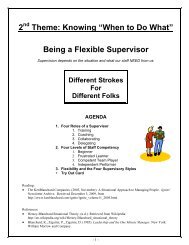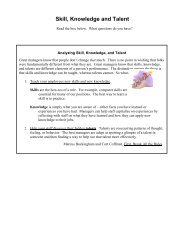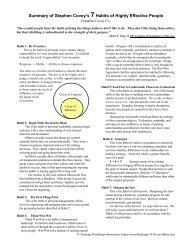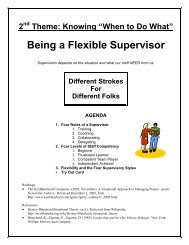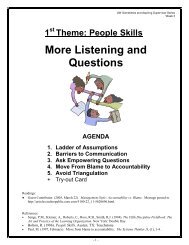Handouts
Handouts
Handouts
You also want an ePaper? Increase the reach of your titles
YUMPU automatically turns print PDFs into web optimized ePapers that Google loves.
The Components of Communication are:COMPONENTS OF COMMUNICATIONApril 29, 2009• Verbal - 7% of any message is communicated through words• Vocal - 38% of a message is relayed by your voice• Visual - 55% is conveyed by non-verbal body languageI. VISUALEYE CONTACTIf you regularly present to rooms of a couple dozen or more, you've probably had the experience of someonecoming up to you afterwards saying how much they enjoyed your talk. Meanwhile you're looking at themwondering where they were hiding because you're absolutely certain you never saw them until this instant.The issue here is eye contact. Most presenters have no trouble creating sincere eye contact when they're one onone with someone. But as the number of people increases unusual behaviors begin to emerge.What happens when you do make contact with the other person? How long are you in their eyes? Normally,people maintain eye contact for less and less time as the number of people in the room increases. If there's adozen or more, most presenters seem to have their eyes wired to some radar scanning program.As you think about eye contact for yourself, give yourself two challenges. First, tell yourself that you're going toincrease the amount of time you look at each person. Don't allow your eyes to move to someone else untilyou've reached an internal count of at least "three-Mississippi." Five Mississippi’s are even better.Second, play a game with yourself. Promise yourself some reward if, by the end of your presentation, you candescribe what everyone in the room is wearing. The point isn't to make you into some fashion maven, but toforce you to actually look at each person and register them consciously.Whether you're in a room of one hundred people or just two, looking each person in the eye is critical toestablishing trust. The truth is simple: unless your eye contact with each person is prolonged and sincere, youcan't succeed as a communicator.GESTURESLike vocal variety, gestures help alter the stream of input your watchers are receiving, and any new input is agood thing. As you become aware of your own gestures, ask some simple questions. First, what are your handsdoing when they're not gesturing? In other words, what's your neutral gesture?Some choices that do not convey confidence or leadership and should be eliminated as a neutral gesture:• Elbows fairly straight with your hands clasped in front of your groin;• Hands clasped behind your back;• One hand crossing your body to grasp the opposite elbow;• Both hands crossed over your chest.1



